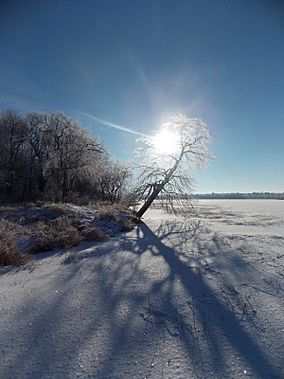Tamarac National Wildlife Refuge facts for kids
Quick facts for kids Tamarac National Wildlife Refuge |
|
|---|---|
|
IUCN Category IV (Habitat/Species Management Area)
|
|
 |
|
| Location | Becker County, Minnesota, United States |
| Nearest city | Detroit Lakes, Minnesota |
| Area | 42,724 acres (172.90 km2) |
| Established | 1938 |
| Governing body | U.S. Fish and Wildlife Service |
| Website | Tamarac National Wildlife Refuge |
The Tamarac National Wildlife Refuge is a special place in the United States. It is a National Wildlife Refuge, which means it is protected land. You can find it in northwestern Minnesota, about 18 miles (29 km) northeast of Detroit Lakes.
This refuge was created in 1938. Its main job is to be a safe home for migratory birds and other wildlife. Migratory birds are those that travel long distances each year. The refuge covers a huge area, about 42,724 acres (172.90 km2). That's bigger than many cities!
Contents
What Makes Tamarac Special?
Tamarac National Wildlife Refuge is known for its beautiful and varied landscape. It has rolling hills covered in forests. You will also see many lakes, rivers, and wet areas like marshes and bogs. These different areas make it a perfect home for many kinds of plants and animals.
The Tamarack Tree
The refuge is named after a very special tree called the tamarack. This tree is quite unusual! Most conifer trees, like pines and spruces, keep their needles all year. But the tamarack is a deciduous conifer. This means it loses its needles, just like oak or maple trees lose their leaves.
In the fall, before its needles drop, the tamarack tree turns a bright, beautiful gold. It's a stunning sight to see!
Where Different Worlds Meet
Tamarac National Wildlife Refuge is in a unique spot in North America. It's where three different types of natural areas come together:
- Northern hardwood forests (like oak and maple trees)
- Coniferous forests (like pine and spruce trees)
- The tallgrass prairie (open grasslands)
Because these different habitats meet here, Tamarac has an amazing variety of wildlife. You can find animals that live in woodlands, and also those that prefer open prairies.
Visiting Tamarac Refuge
If you visit Tamarac, you can stop by the visitor center. It offers a great view of the marshes and trees that make the refuge so special. Inside, you can watch a short film that tells you more about the history and nature of this unique place. It's a great way to learn about the animals and plants you might see!


